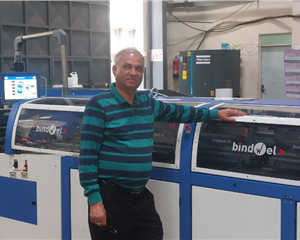How much ‘green’ is industrial printing ink? - The Noel D'Cunha Sunday Column
The selection of inks now seems to become a selection of a lesser evil – ‘safer’ or ‘greener’. Industrial printing inks are increasingly being billed as ‘green’, but can printing inks, in general, really fall under this category a 100%?
Sherry Washburn, supplies business unit manager at Videojet Technologies, takes a closer look at the green aspects of industrial printing inks even as we put forth the question on the ‘green’ quotient to the printing ink makers in India.
In this Sunday Column, Washburn and few Indian ink makers discuss if printing inks can they ever be truly green
28 Apr 2019 | By Noel D'Cunha
Industrial printing inks are increasingly being billed as ‘green’, but what does that mean in reality? How does being green identify with industrial fluids? And are these claims simply paying lip service to those looking to make a positive impact in terms of the inks and make-up fluids they use? “There is no clear definition or standard on what it means to be a ‘green’ ink,” says Sherry Washburn, supplies business unit manager at Videojet Technologies.
So, “green” for anything, in the context of environmental friendliness is – cradle to cradle. If the material can be reborn with reasonable efforts, it should be considered “green”, says Bhaumik Mehta, managing director at Flueron Inks, a Navi Mumbai-based ink manufacturer producing inks for metal printing among others. “Printing inks, in general, can’t really fall under this category a 100%. The materials ink manufacturers rely on some way, shape or form derived from hydrocarbon feedstocks, even if it is at a lower percentage – be it, seed oil-based inks, aqueous inks, UV/LED/EB inks or solvent inks. So time to reborn is essentially extremely long or unrealistic.”

Sherry Washburn, supplies business unit manager at Videojet Technologies
Manufacturers, in order to keep up with demanding production schedules, require fast dry times and excellent adhesion, which involves the use of solvents such as ketones and alcohols. These fast-drying industrial solvents are flammable, volatile, organic compounds (VOCs); therefore, industrial inkjet inks are starting out with a hazardous material that is not necessarily in keeping with the notion of being ‘green’. “VOCs are heavier than air, contribute to ground level smog, and some VOCs participate in photochemical reactions in the atmosphere that cause damage to the ozone layer,” explains Washburn.
Mehta agrees with Washburn. “Definition of VOCs is spot on. The practical application requires productivity and manufacturing efficiency, hence use of solvents is unavoidable.” It is especially true when solvent-based inks are referred to. “A workaround to these products is water-based or aqueous inks, where the majority of the formulation relies on water as a diluent.”
But even though VOCs are hazardous, they are everywhere – including in gasoline, ethanol used in vodka, and even isopropanol (IPA) in medical wipes. Washburn says, “Anything that evaporates and contains carbon is classed as a VOC and so we are all in contact with them in some form or another throughout the course of everyday life.”
Life wouldn’t be the same without some “spirits” right? “Yes they could be considered as VOC technically, however, the amount of these consumed/used per unit area on any part of the earth isn’t anywhere close to what we are talking about here. Also, they may not be as easily broken down into smaller molecules to affect the ozone layers,” explains Mehta.
What can be done to make inks ‘greener’
There are three approaches to making a ‘greener’ ink; water-based, safer solvent, or Corporate Social Responsibility (CSR) goals. The first approach is using water, which is VOC-free. However, water evaporates so slowly that the dry time experienced on production lines will be longer than manufacturer requirements. Washburn says, “If there isn’t sufficient time available during the coding and marking process, then the ink would need drying assistance. Additional energy would be consumed with this approach which negates its ‘green’ benefits'.”
Mehta adds, forced drying techniques like IR energy or similar consume electricity/gas etc to work. “Hence the 'green' advantage is negated.”

Bhaumik Mehta, managing director at Flueron Inks
If a water-based solution is not feasible, a second approach would be to utilise a safer solvent, acetone, which is exempt from the U.S. Environmental Protection Agency (EPA) Clean Air Act. “Acetone does not participate in photochemical reactions in the upper atmosphere; therefore, it does not deplete the ozone layer. Another option is to formulate with ethanol which has low odour and frequently found in the food and beverage industry. Ethanol has been used throughout human history safely for a variety of applications,” explains Washburn.
The last approach involves ink formulations which meet company CSR goals such as non-carcinogens, mutagens, reproductive toxins (CMRs), food contact materials, or controlled substances
This is where the EB/UV/LED ink technology really has a great advantage. “Firstly it is 100% or nearly 100% solids, no ink constituents “flash off” into the air, the raw material technology is constantly evolving with various CMR restricted materials being replaced by CMR-less materials. However, it is not green at all. In my opinion, the ink per se is better for the air since no material makes it to the ozone. UV lamp, however, does react with the oxygen and breaks it down to create more ozone. LED doesn’t do that at all and is safer to use,” emphasises Mehta.
Ink is derived from mostly all hydrocarbon feedstock, which is extremely difficult to be considered cradle to cradle, at this point. Mehta says, “Future research may bring the time frame to come back to life shorter, but time will tell.”
If we break inks down into their constituent parts, there are areas that can be targeted in terms of making them less of a ‘toxic’ fluid. Manufacturers should review ink constituents for all hazards, particularly CMRs. It can be desirable to remove ink constituents that are classified as CMRs and to replace them with an alternative, and it is possible to do this without having an impact on application performance.
Washburn says, Videojet has a long-standing policy not to use CMRs in its new development process. "Environmental, health, and safety reviews are completed on every ink constituent before it is allowed to be used in new ink development. The inks and fluids we produce do not contain CMRs and could be deemed to be ‘greener’. The issue here is that there is no concrete definition as to what ‘green’ means; therefore, our own preference is to not use the term at all. Rather, we prefer to promote the fact that we are able to help our customers reach their own respective goals in terms of CSR."
CSR goals
In a way, the CSR goals are to be in tune with the end-users demand. If the end user wants to go for a safer alternative and make it easier on the environment, by all means, LED inks could be a great solution. “Not green, but safer for the immediate greenhouse gas emissions or GHGs,” says Mehta.
Could we consider aqueous inks as inks with lower carbon footprint? “Yes,” says Mehta. “But talking about ~50% water being flashed off, you are getting 50% of the ink deposited and other 50% being flashed off. So again you’ll end up using 50% more ink vs UV/LED. Additionally, you have to rely on acetone kind of VOC exempt solvents for better drying characteristics. With UV/LED that isn’t the case.”
Yes, recyclability of packaging printed with UV/LED is questionable for the same reasons as stated above (hydrocarbon feedstock and break down to smaller molecules is time consuming), but immediate air or ozone is not compromised as much. Mehta says, “All this comes down to cost, if you ask me. If the end user is demanding a greener solution, the cost of research or cost of inks has to be passed on until it is justified to switch to greener solutions.”
Manufacturers should look to expert suppliers of inks and fluids that work closely with customers to learn what is important to them with respect to their CSR goals. Washburn says, “Most commonly, we are asked for no MEK, low odour, and inks that are suitable for food packaging. In order to make these more easily identifiable, they have been classified under iQMark.”
The proliferation of requirements that customers have to consider continues to grow exponentially, and Washburn says, her company sees it as its responsibility as a supplier to support them as closely as possible where CSR and compliance are concerned. “iQMark simplifies the way supplies are ordered in terms of how they fit in with individual CSR goals and makes the process of identifying and selecting inks as seamless as possible. In addition, the ink delivery method of certain systems can contribute to CSR goals. Empty smart cartridges are not only recyclable, but they also are no longer hazardous materials.”
Datasheets are readily available that enable the regulatory landscape to be factored into the selection process. Legislation such as the Swiss Food Packaging Ordinance, the Clean Air Act (US), and a number of similar acts implemented globally can be quickly identified and assurances provided that the ink is in compliance.
Swiss, German, Nestle, EPA, Japanese, Chinese Blue sky initiatives are excellent regulations geared toward achieving green solutions, but alternatives are not as easily identified or practical to use currently. “It’ll get there, but we need it yesterday,” says an amused Mehta.
The question is not, is it green?
When considering the best possible industrial inks for a production line, the question of whether that ink can be considered green is always going to be vastly open to interpretation. If the ink is marketed as ‘green’ then there are other questions that should follow. What is its composition? Does it contain a VOC? If not, will it be suitable for the line speeds required? Will drying assistance be necessary?
Washburn says, “As I have mentioned, the word ‘green’ is open to interpretation. Therefore, it is far better to select inks and fluids based on how they integrate with a company’s own CSR goals and strategies, coupled with regulatory requirements. Through working with an expert supplier, every element that feeds into those CSR frameworks can be closely scrutinised and the best possible outcomes delivered.”
End-user goals define the technology deployed like it is the case with most products. “But as an ink manufacturer, it is imperative that we educate the end user to make a smarter/ informed choice. That’s when the research and cost will be justified,” says Mehta.
Zainul Lakdawala, ink consultant
To the best of my knowledge, there are no standards for “green” inks. Sheetfed inks which have above 25% of soy oil, can have a Soya Seal, which is being practised in North America.
Inkjet technologist should explore the feasibility of using Ethyl alcohol as a solvent. Alternatively, an Energy Curable chemistry which has no VOC can also be explored. However, UV/LED inks require energy to cure the printed products.
Water-based technology is being employed but I understand UV/LED technology is also catching up.
Most of printing inks manufacturers here comply with SVHC (substance of very High concern) guidelines and are continuously updating printing inks to be cleaner.
Reynold D'Souza, GM R&D at Sakata Inx India
I agree right now there is no universal definition of green ink and perhaps this is impossible. There is a possibility within each ink type. Green would mean in respect to the environment and would need to include air, water and printed waste. So concentrating primarily on VOC may address only some of the issues.
A further complication is the manner of disposal of the final print or ink. For instance, by one method it may be okay and by the other not so. For instance, the Cladel de-inking method may be facing some issues with certain types of inks. I am in discussion with Nestle on this point.
India has implemented the Basel Convention strictly so one needs to see parameters such as Category C. Dr Claude Alvarez from Mapusa (Goa Foundation) who was the Supreme Court appointee was once on the Basel Convention in India. Ink implications do exist here. Hence, if you refer to the EUPIA document, each ink has its nuances.
BS Kampani, managing director, YC Inks

Frankly speaking, people are debating for the sake of ‘green’, when it has no meaning. People do not realise that it takes years to perfect a technology – to match the speed, sharp dots to make the graphics as realistic, get scrumping to zero and dot gains within nano limits. If even linseed and soya oil formulations with certain phenolic resins are not green in terms of VOC, then what is. The heavy metals too, have been taken care of.
CSR is totally misinterpreted in India and when it was brought to India, it was with an eye to help underprivileged children, senior citizens, or animal species to help them survive their breeds.
The environment is a priority in user industries like fertilisers and automobiles to name just two, who leave a much-polluted environment with toxins that are life-threatening. More time and resources need to given here.
Similarly water-based in gravure, high-speed printing is next to impossible for the kind of machine speeds India is looking for. So, it is better not to talk about water-based as it has a lot of limitations. We can look upon speed improvement by understanding the evaporation process and see how to accelerate this process. Mainly by the controlled air pressure in the ovens, so that water and its added solvent would evaporate at a lower temperature.
I have personally worked on this principle and seen success. But then which ink maker or printer is ready for this route and would the speed be the same as the solvent base. So going green other than elimination of toxins to a tolerable level is next to impossible for the next decade or so.
‘Going green’ is a ‘fad talk’ and would only confuse the formulation or might even make him go bust in his investments.
Gaurav Sathaye, director, United Ink
Selection of ink is truly a selection of lesser evil and a ‘safer’ or ‘greener’ option vis-à-vis the performance expectation.
Every segment of application and every ink formulations or base chemistry will face a similar selection criterion to select the best formulation considering various elements such as: printability/productivity; performance and resistance properties; cost and profitability; and environment, health and safety.
In the industrial segments, the performance is most important as there may be a need for specific drying times or adhesion parameters that can only be achieved by a certain solvent or by proper pre-treatment of the film. In such cases, it is important for the converter to ensure steps are taken towards solvent recovery and personal protective equipment/ safety precautions to contain the damage from this choice.
Unfortunately, sometimes the EHS norms are often ignored by some due to high reliance on performance or cost and it is hence more important for the regulatory intervention to keep things within the check.
It is important for the government authorities and the regulators to work closely with the industry to work out a balancing act of drafting practical and achievable regulations and policy to ensure safe working environments and sustainability while keeping the cost of the technology affordable.















 See All
See All